M&S Strategic Analysis: Market, Competition, and Strategy
VerifiedAdded on 2024/06/05
|19
|4093
|164
Report
AI Summary
This report provides a strategic analysis of Marks and Spencer (M&S), a leading UK retailer. It begins with an overview of the company, its mission, and vision, followed by a competitive analysis of its environment. The report employs Porter's Five Forces to assess the threats of new entrants and substitute products, the bargaining power of buyers and suppliers, and the intensity of competitive rivalry. It then delves into M&S's environmental conditions, utilizing Porter's Generic Model to discuss differentiation and diversification strategies. The analysis includes current environmental practices of M&S, a PESTEL analysis, and a SWOT analysis. The report concludes with a discussion of findings, recommendations, and references, providing a comprehensive strategic overview of M&S's business environment and competitive positioning.
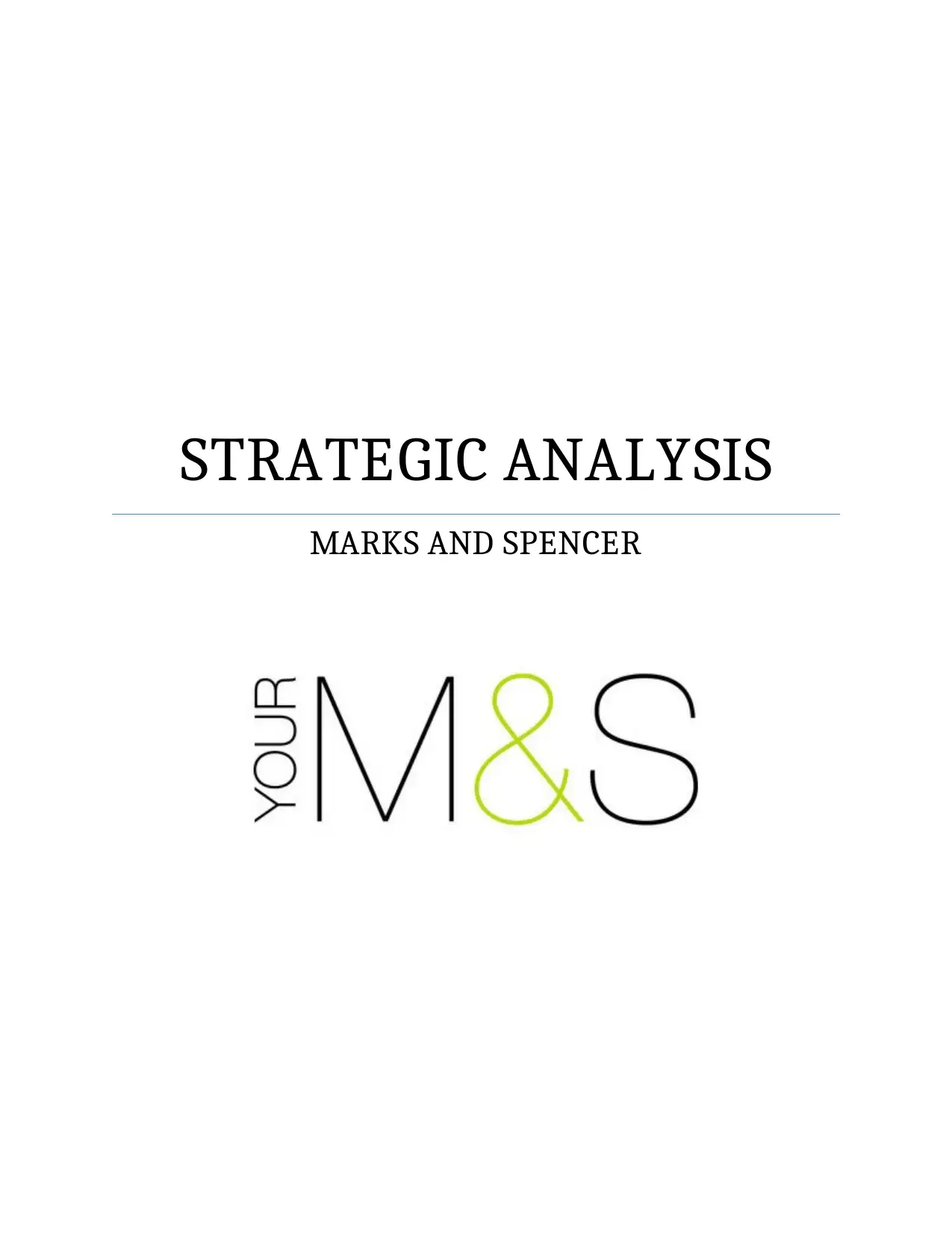
STRATEGIC ANALYSIS
MARKS AND SPENCER
MARKS AND SPENCER
Paraphrase This Document
Need a fresh take? Get an instant paraphrase of this document with our AI Paraphraser
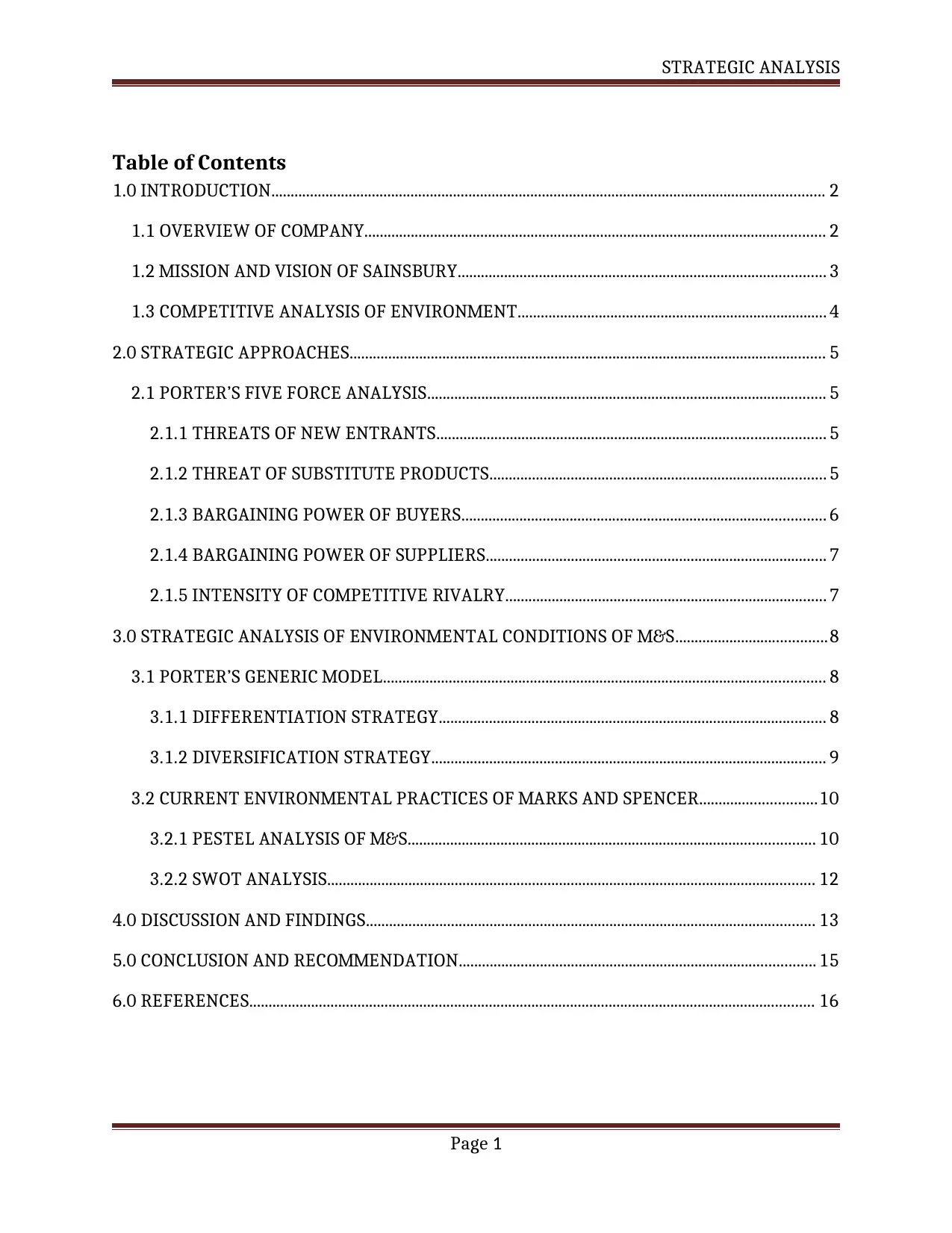
STRATEGIC ANALYSIS
Table of Contents
1.0 INTRODUCTION............................................................................................................................................... 2
1.1 OVERVIEW OF COMPANY....................................................................................................................... 2
1.2 MISSION AND VISION OF SAINSBURY............................................................................................... 3
1.3 COMPETITIVE ANALYSIS OF ENVIRONMENT................................................................................ 4
2.0 STRATEGIC APPROACHES........................................................................................................................... 5
2.1 PORTER’S FIVE FORCE ANALYSIS....................................................................................................... 5
2.1.1 THREATS OF NEW ENTRANTS.................................................................................................... 5
2.1.2 THREAT OF SUBSTITUTE PRODUCTS....................................................................................... 5
2.1.3 BARGAINING POWER OF BUYERS.............................................................................................. 6
2.1.4 BARGAINING POWER OF SUPPLIERS........................................................................................ 7
2.1.5 INTENSITY OF COMPETITIVE RIVALRY................................................................................... 7
3.0 STRATEGIC ANALYSIS OF ENVIRONMENTAL CONDITIONS OF M&S.......................................8
3.1 PORTER’S GENERIC MODEL.................................................................................................................. 8
3.1.1 DIFFERENTIATION STRATEGY.................................................................................................... 8
3.1.2 DIVERSIFICATION STRATEGY...................................................................................................... 9
3.2 CURRENT ENVIRONMENTAL PRACTICES OF MARKS AND SPENCER..............................10
3.2.1 PESTEL ANALYSIS OF M&S......................................................................................................... 10
3.2.2 SWOT ANALYSIS.............................................................................................................................. 12
4.0 DISCUSSION AND FINDINGS.................................................................................................................... 13
5.0 CONCLUSION AND RECOMMENDATION............................................................................................ 15
6.0 REFERENCES.................................................................................................................................................. 16
Page 1
Table of Contents
1.0 INTRODUCTION............................................................................................................................................... 2
1.1 OVERVIEW OF COMPANY....................................................................................................................... 2
1.2 MISSION AND VISION OF SAINSBURY............................................................................................... 3
1.3 COMPETITIVE ANALYSIS OF ENVIRONMENT................................................................................ 4
2.0 STRATEGIC APPROACHES........................................................................................................................... 5
2.1 PORTER’S FIVE FORCE ANALYSIS....................................................................................................... 5
2.1.1 THREATS OF NEW ENTRANTS.................................................................................................... 5
2.1.2 THREAT OF SUBSTITUTE PRODUCTS....................................................................................... 5
2.1.3 BARGAINING POWER OF BUYERS.............................................................................................. 6
2.1.4 BARGAINING POWER OF SUPPLIERS........................................................................................ 7
2.1.5 INTENSITY OF COMPETITIVE RIVALRY................................................................................... 7
3.0 STRATEGIC ANALYSIS OF ENVIRONMENTAL CONDITIONS OF M&S.......................................8
3.1 PORTER’S GENERIC MODEL.................................................................................................................. 8
3.1.1 DIFFERENTIATION STRATEGY.................................................................................................... 8
3.1.2 DIVERSIFICATION STRATEGY...................................................................................................... 9
3.2 CURRENT ENVIRONMENTAL PRACTICES OF MARKS AND SPENCER..............................10
3.2.1 PESTEL ANALYSIS OF M&S......................................................................................................... 10
3.2.2 SWOT ANALYSIS.............................................................................................................................. 12
4.0 DISCUSSION AND FINDINGS.................................................................................................................... 13
5.0 CONCLUSION AND RECOMMENDATION............................................................................................ 15
6.0 REFERENCES.................................................................................................................................................. 16
Page 1
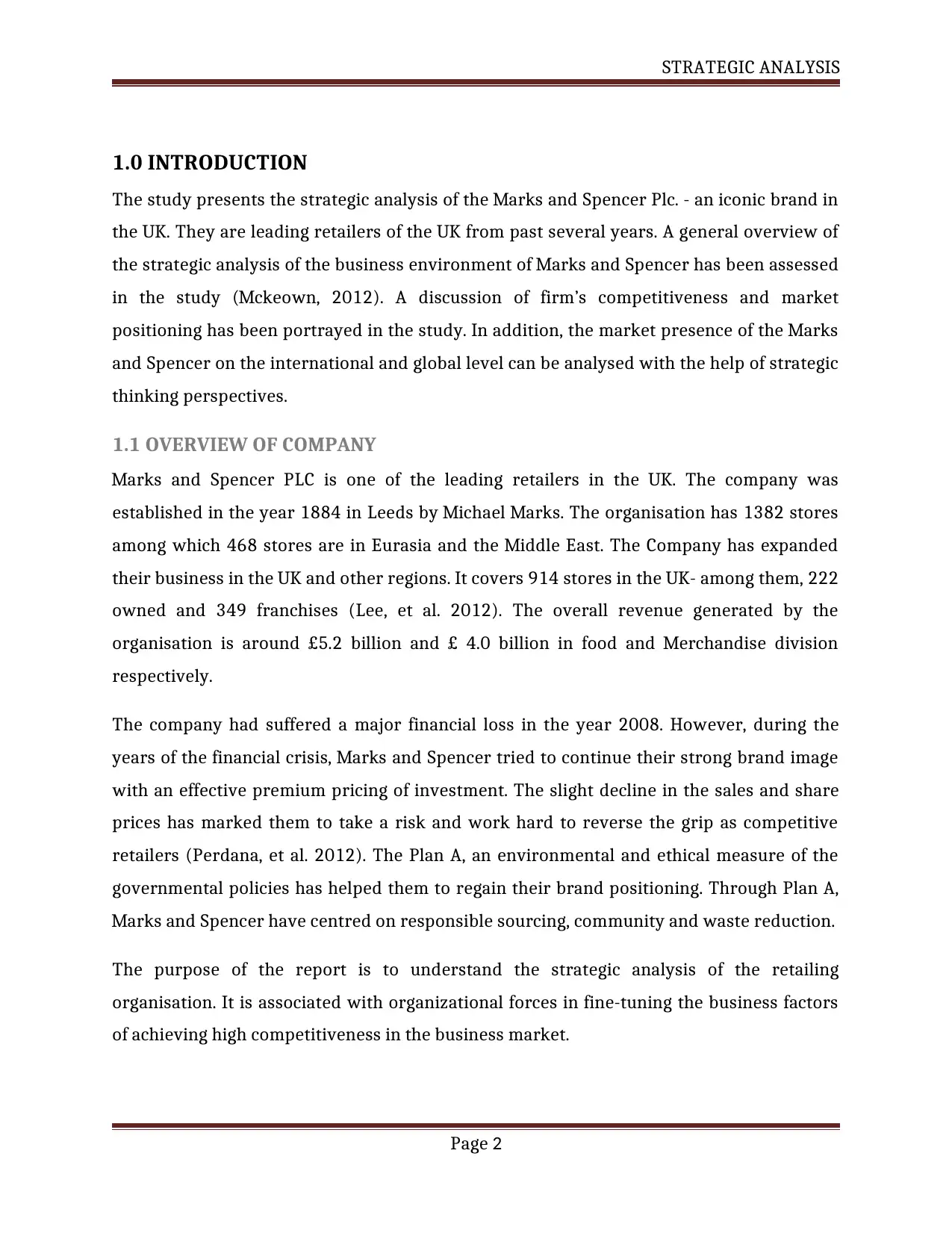
STRATEGIC ANALYSIS
1.0 INTRODUCTION
The study presents the strategic analysis of the Marks and Spencer Plc. - an iconic brand in
the UK. They are leading retailers of the UK from past several years. A general overview of
the strategic analysis of the business environment of Marks and Spencer has been assessed
in the study (Mckeown, 2012). A discussion of firm’s competitiveness and market
positioning has been portrayed in the study. In addition, the market presence of the Marks
and Spencer on the international and global level can be analysed with the help of strategic
thinking perspectives.
1.1 OVERVIEW OF COMPANY
Marks and Spencer PLC is one of the leading retailers in the UK. The company was
established in the year 1884 in Leeds by Michael Marks. The organisation has 1382 stores
among which 468 stores are in Eurasia and the Middle East. The Company has expanded
their business in the UK and other regions. It covers 914 stores in the UK- among them, 222
owned and 349 franchises (Lee, et al. 2012). The overall revenue generated by the
organisation is around £5.2 billion and £ 4.0 billion in food and Merchandise division
respectively.
The company had suffered a major financial loss in the year 2008. However, during the
years of the financial crisis, Marks and Spencer tried to continue their strong brand image
with an effective premium pricing of investment. The slight decline in the sales and share
prices has marked them to take a risk and work hard to reverse the grip as competitive
retailers (Perdana, et al. 2012). The Plan A, an environmental and ethical measure of the
governmental policies has helped them to regain their brand positioning. Through Plan A,
Marks and Spencer have centred on responsible sourcing, community and waste reduction.
The purpose of the report is to understand the strategic analysis of the retailing
organisation. It is associated with organizational forces in fine-tuning the business factors
of achieving high competitiveness in the business market.
Page 2
1.0 INTRODUCTION
The study presents the strategic analysis of the Marks and Spencer Plc. - an iconic brand in
the UK. They are leading retailers of the UK from past several years. A general overview of
the strategic analysis of the business environment of Marks and Spencer has been assessed
in the study (Mckeown, 2012). A discussion of firm’s competitiveness and market
positioning has been portrayed in the study. In addition, the market presence of the Marks
and Spencer on the international and global level can be analysed with the help of strategic
thinking perspectives.
1.1 OVERVIEW OF COMPANY
Marks and Spencer PLC is one of the leading retailers in the UK. The company was
established in the year 1884 in Leeds by Michael Marks. The organisation has 1382 stores
among which 468 stores are in Eurasia and the Middle East. The Company has expanded
their business in the UK and other regions. It covers 914 stores in the UK- among them, 222
owned and 349 franchises (Lee, et al. 2012). The overall revenue generated by the
organisation is around £5.2 billion and £ 4.0 billion in food and Merchandise division
respectively.
The company had suffered a major financial loss in the year 2008. However, during the
years of the financial crisis, Marks and Spencer tried to continue their strong brand image
with an effective premium pricing of investment. The slight decline in the sales and share
prices has marked them to take a risk and work hard to reverse the grip as competitive
retailers (Perdana, et al. 2012). The Plan A, an environmental and ethical measure of the
governmental policies has helped them to regain their brand positioning. Through Plan A,
Marks and Spencer have centred on responsible sourcing, community and waste reduction.
The purpose of the report is to understand the strategic analysis of the retailing
organisation. It is associated with organizational forces in fine-tuning the business factors
of achieving high competitiveness in the business market.
Page 2
⊘ This is a preview!⊘
Do you want full access?
Subscribe today to unlock all pages.

Trusted by 1+ million students worldwide
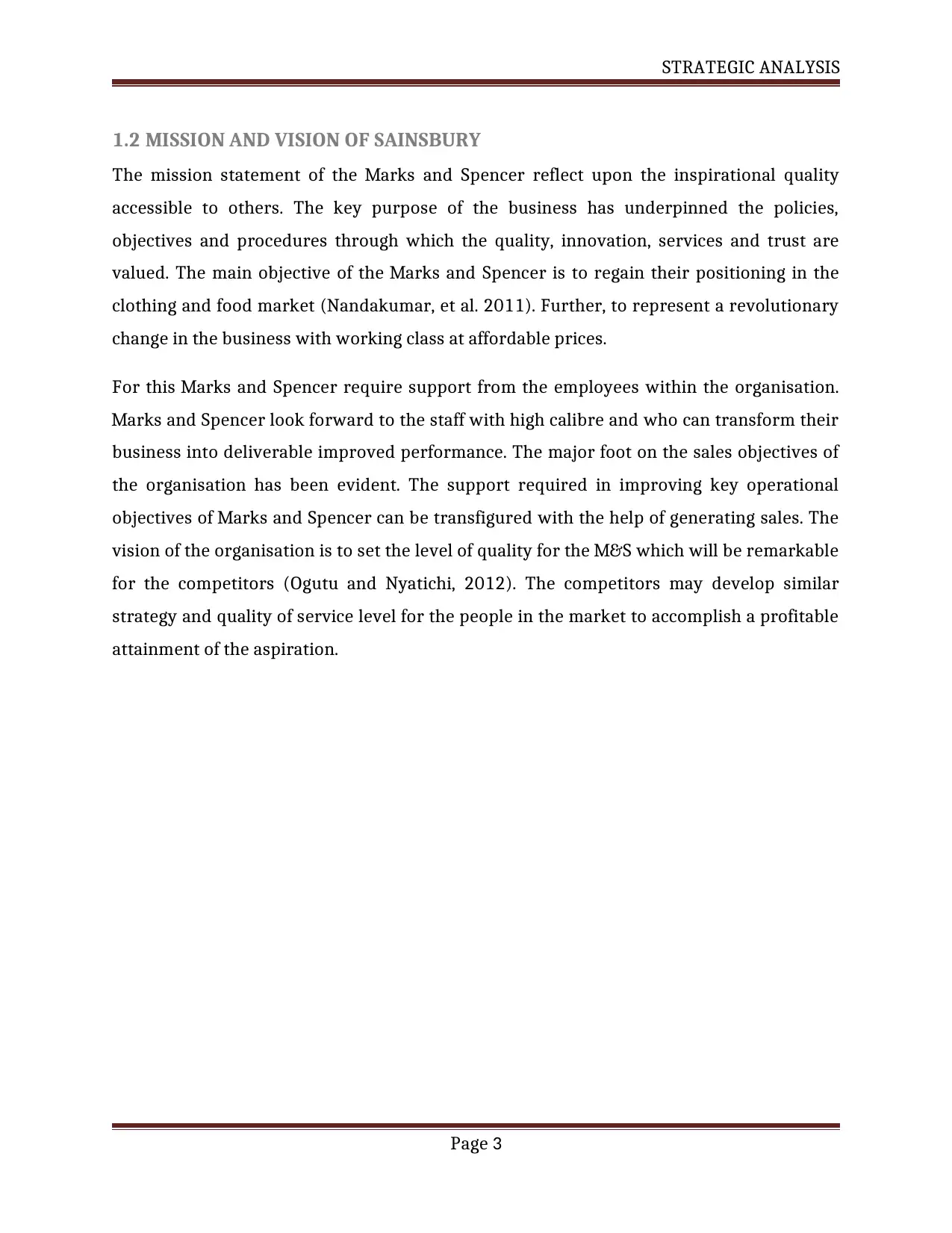
STRATEGIC ANALYSIS
1.2 MISSION AND VISION OF SAINSBURY
The mission statement of the Marks and Spencer reflect upon the inspirational quality
accessible to others. The key purpose of the business has underpinned the policies,
objectives and procedures through which the quality, innovation, services and trust are
valued. The main objective of the Marks and Spencer is to regain their positioning in the
clothing and food market (Nandakumar, et al. 2011). Further, to represent a revolutionary
change in the business with working class at affordable prices.
For this Marks and Spencer require support from the employees within the organisation.
Marks and Spencer look forward to the staff with high calibre and who can transform their
business into deliverable improved performance. The major foot on the sales objectives of
the organisation has been evident. The support required in improving key operational
objectives of Marks and Spencer can be transfigured with the help of generating sales. The
vision of the organisation is to set the level of quality for the M&S which will be remarkable
for the competitors (Ogutu and Nyatichi, 2012). The competitors may develop similar
strategy and quality of service level for the people in the market to accomplish a profitable
attainment of the aspiration.
Page 3
1.2 MISSION AND VISION OF SAINSBURY
The mission statement of the Marks and Spencer reflect upon the inspirational quality
accessible to others. The key purpose of the business has underpinned the policies,
objectives and procedures through which the quality, innovation, services and trust are
valued. The main objective of the Marks and Spencer is to regain their positioning in the
clothing and food market (Nandakumar, et al. 2011). Further, to represent a revolutionary
change in the business with working class at affordable prices.
For this Marks and Spencer require support from the employees within the organisation.
Marks and Spencer look forward to the staff with high calibre and who can transform their
business into deliverable improved performance. The major foot on the sales objectives of
the organisation has been evident. The support required in improving key operational
objectives of Marks and Spencer can be transfigured with the help of generating sales. The
vision of the organisation is to set the level of quality for the M&S which will be remarkable
for the competitors (Ogutu and Nyatichi, 2012). The competitors may develop similar
strategy and quality of service level for the people in the market to accomplish a profitable
attainment of the aspiration.
Page 3
Paraphrase This Document
Need a fresh take? Get an instant paraphrase of this document with our AI Paraphraser
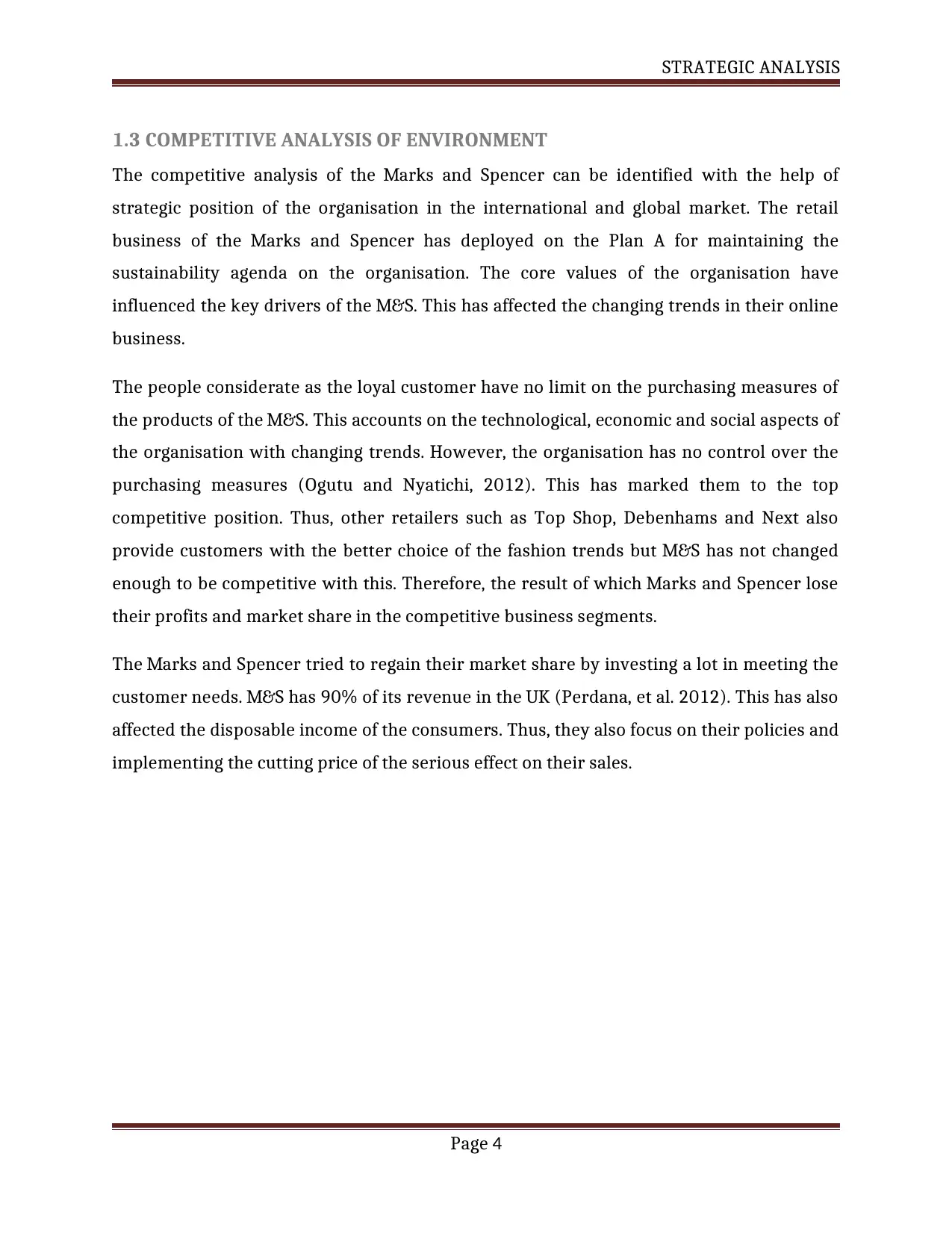
STRATEGIC ANALYSIS
1.3 COMPETITIVE ANALYSIS OF ENVIRONMENT
The competitive analysis of the Marks and Spencer can be identified with the help of
strategic position of the organisation in the international and global market. The retail
business of the Marks and Spencer has deployed on the Plan A for maintaining the
sustainability agenda on the organisation. The core values of the organisation have
influenced the key drivers of the M&S. This has affected the changing trends in their online
business.
The people considerate as the loyal customer have no limit on the purchasing measures of
the products of the M&S. This accounts on the technological, economic and social aspects of
the organisation with changing trends. However, the organisation has no control over the
purchasing measures (Ogutu and Nyatichi, 2012). This has marked them to the top
competitive position. Thus, other retailers such as Top Shop, Debenhams and Next also
provide customers with the better choice of the fashion trends but M&S has not changed
enough to be competitive with this. Therefore, the result of which Marks and Spencer lose
their profits and market share in the competitive business segments.
The Marks and Spencer tried to regain their market share by investing a lot in meeting the
customer needs. M&S has 90% of its revenue in the UK (Perdana, et al. 2012). This has also
affected the disposable income of the consumers. Thus, they also focus on their policies and
implementing the cutting price of the serious effect on their sales.
Page 4
1.3 COMPETITIVE ANALYSIS OF ENVIRONMENT
The competitive analysis of the Marks and Spencer can be identified with the help of
strategic position of the organisation in the international and global market. The retail
business of the Marks and Spencer has deployed on the Plan A for maintaining the
sustainability agenda on the organisation. The core values of the organisation have
influenced the key drivers of the M&S. This has affected the changing trends in their online
business.
The people considerate as the loyal customer have no limit on the purchasing measures of
the products of the M&S. This accounts on the technological, economic and social aspects of
the organisation with changing trends. However, the organisation has no control over the
purchasing measures (Ogutu and Nyatichi, 2012). This has marked them to the top
competitive position. Thus, other retailers such as Top Shop, Debenhams and Next also
provide customers with the better choice of the fashion trends but M&S has not changed
enough to be competitive with this. Therefore, the result of which Marks and Spencer lose
their profits and market share in the competitive business segments.
The Marks and Spencer tried to regain their market share by investing a lot in meeting the
customer needs. M&S has 90% of its revenue in the UK (Perdana, et al. 2012). This has also
affected the disposable income of the consumers. Thus, they also focus on their policies and
implementing the cutting price of the serious effect on their sales.
Page 4
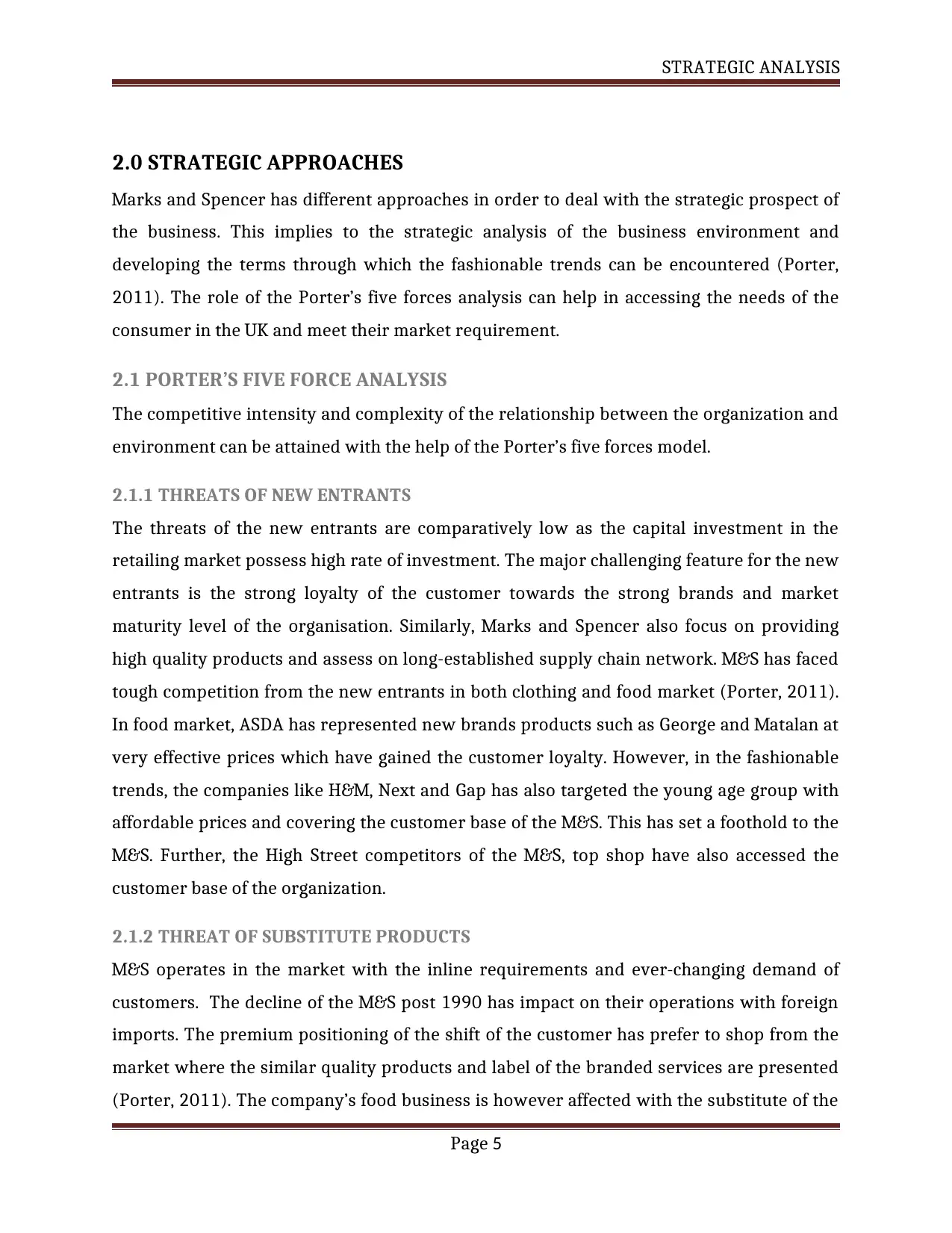
STRATEGIC ANALYSIS
2.0 STRATEGIC APPROACHES
Marks and Spencer has different approaches in order to deal with the strategic prospect of
the business. This implies to the strategic analysis of the business environment and
developing the terms through which the fashionable trends can be encountered (Porter,
2011). The role of the Porter’s five forces analysis can help in accessing the needs of the
consumer in the UK and meet their market requirement.
2.1 PORTER’S FIVE FORCE ANALYSIS
The competitive intensity and complexity of the relationship between the organization and
environment can be attained with the help of the Porter’s five forces model.
2.1.1 THREATS OF NEW ENTRANTS
The threats of the new entrants are comparatively low as the capital investment in the
retailing market possess high rate of investment. The major challenging feature for the new
entrants is the strong loyalty of the customer towards the strong brands and market
maturity level of the organisation. Similarly, Marks and Spencer also focus on providing
high quality products and assess on long-established supply chain network. M&S has faced
tough competition from the new entrants in both clothing and food market (Porter, 2011).
In food market, ASDA has represented new brands products such as George and Matalan at
very effective prices which have gained the customer loyalty. However, in the fashionable
trends, the companies like H&M, Next and Gap has also targeted the young age group with
affordable prices and covering the customer base of the M&S. This has set a foothold to the
M&S. Further, the High Street competitors of the M&S, top shop have also accessed the
customer base of the organization.
2.1.2 THREAT OF SUBSTITUTE PRODUCTS
M&S operates in the market with the inline requirements and ever-changing demand of
customers. The decline of the M&S post 1990 has impact on their operations with foreign
imports. The premium positioning of the shift of the customer has prefer to shop from the
market where the similar quality products and label of the branded services are presented
(Porter, 2011). The company’s food business is however affected with the substitute of the
Page 5
2.0 STRATEGIC APPROACHES
Marks and Spencer has different approaches in order to deal with the strategic prospect of
the business. This implies to the strategic analysis of the business environment and
developing the terms through which the fashionable trends can be encountered (Porter,
2011). The role of the Porter’s five forces analysis can help in accessing the needs of the
consumer in the UK and meet their market requirement.
2.1 PORTER’S FIVE FORCE ANALYSIS
The competitive intensity and complexity of the relationship between the organization and
environment can be attained with the help of the Porter’s five forces model.
2.1.1 THREATS OF NEW ENTRANTS
The threats of the new entrants are comparatively low as the capital investment in the
retailing market possess high rate of investment. The major challenging feature for the new
entrants is the strong loyalty of the customer towards the strong brands and market
maturity level of the organisation. Similarly, Marks and Spencer also focus on providing
high quality products and assess on long-established supply chain network. M&S has faced
tough competition from the new entrants in both clothing and food market (Porter, 2011).
In food market, ASDA has represented new brands products such as George and Matalan at
very effective prices which have gained the customer loyalty. However, in the fashionable
trends, the companies like H&M, Next and Gap has also targeted the young age group with
affordable prices and covering the customer base of the M&S. This has set a foothold to the
M&S. Further, the High Street competitors of the M&S, top shop have also accessed the
customer base of the organization.
2.1.2 THREAT OF SUBSTITUTE PRODUCTS
M&S operates in the market with the inline requirements and ever-changing demand of
customers. The decline of the M&S post 1990 has impact on their operations with foreign
imports. The premium positioning of the shift of the customer has prefer to shop from the
market where the similar quality products and label of the branded services are presented
(Porter, 2011). The company’s food business is however affected with the substitute of the
Page 5
⊘ This is a preview!⊘
Do you want full access?
Subscribe today to unlock all pages.

Trusted by 1+ million students worldwide
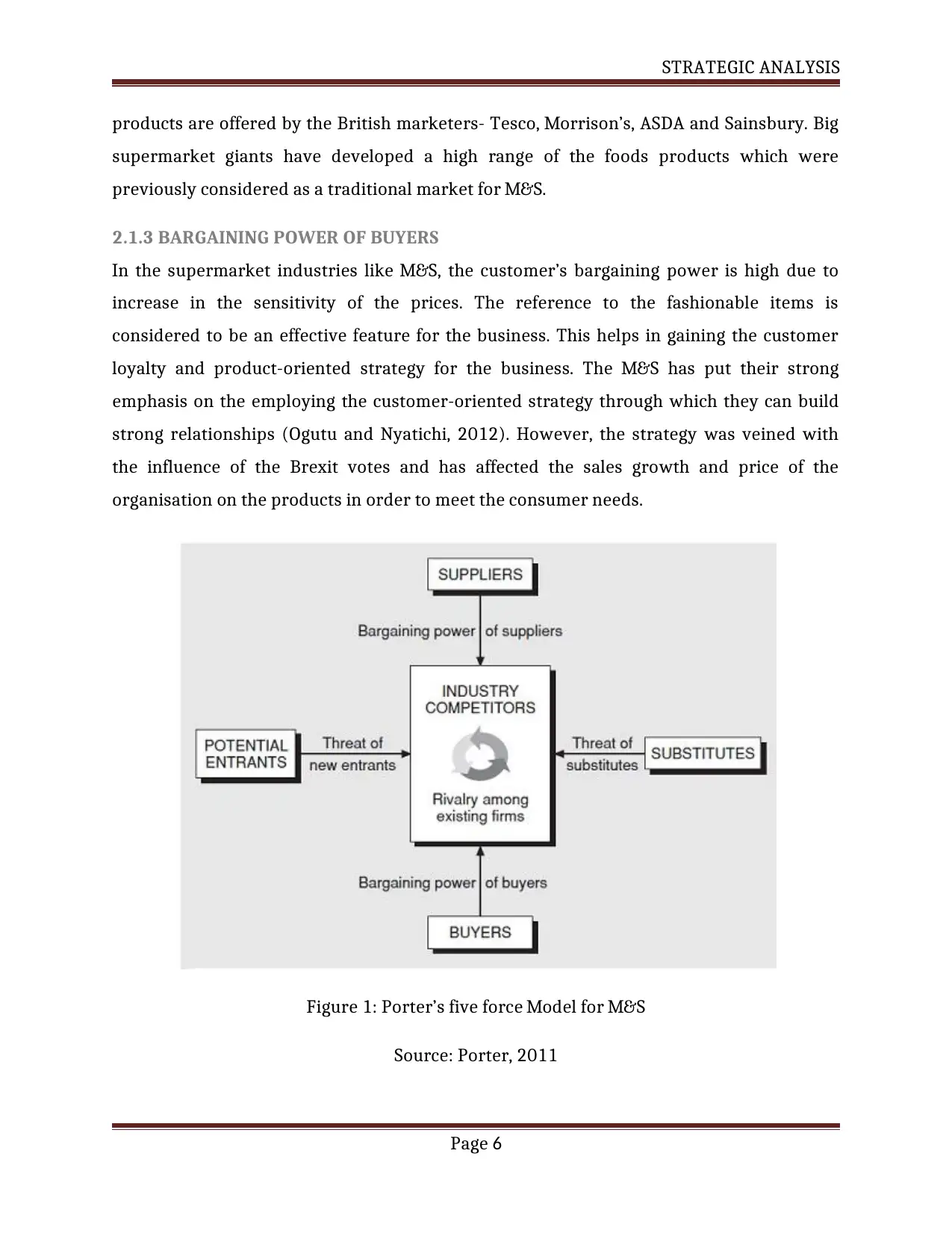
STRATEGIC ANALYSIS
products are offered by the British marketers- Tesco, Morrison’s, ASDA and Sainsbury. Big
supermarket giants have developed a high range of the foods products which were
previously considered as a traditional market for M&S.
2.1.3 BARGAINING POWER OF BUYERS
In the supermarket industries like M&S, the customer’s bargaining power is high due to
increase in the sensitivity of the prices. The reference to the fashionable items is
considered to be an effective feature for the business. This helps in gaining the customer
loyalty and product-oriented strategy for the business. The M&S has put their strong
emphasis on the employing the customer-oriented strategy through which they can build
strong relationships (Ogutu and Nyatichi, 2012). However, the strategy was veined with
the influence of the Brexit votes and has affected the sales growth and price of the
organisation on the products in order to meet the consumer needs.
Figure 1: Porter’s five force Model for M&S
Source: Porter, 2011
Page 6
products are offered by the British marketers- Tesco, Morrison’s, ASDA and Sainsbury. Big
supermarket giants have developed a high range of the foods products which were
previously considered as a traditional market for M&S.
2.1.3 BARGAINING POWER OF BUYERS
In the supermarket industries like M&S, the customer’s bargaining power is high due to
increase in the sensitivity of the prices. The reference to the fashionable items is
considered to be an effective feature for the business. This helps in gaining the customer
loyalty and product-oriented strategy for the business. The M&S has put their strong
emphasis on the employing the customer-oriented strategy through which they can build
strong relationships (Ogutu and Nyatichi, 2012). However, the strategy was veined with
the influence of the Brexit votes and has affected the sales growth and price of the
organisation on the products in order to meet the consumer needs.
Figure 1: Porter’s five force Model for M&S
Source: Porter, 2011
Page 6
Paraphrase This Document
Need a fresh take? Get an instant paraphrase of this document with our AI Paraphraser
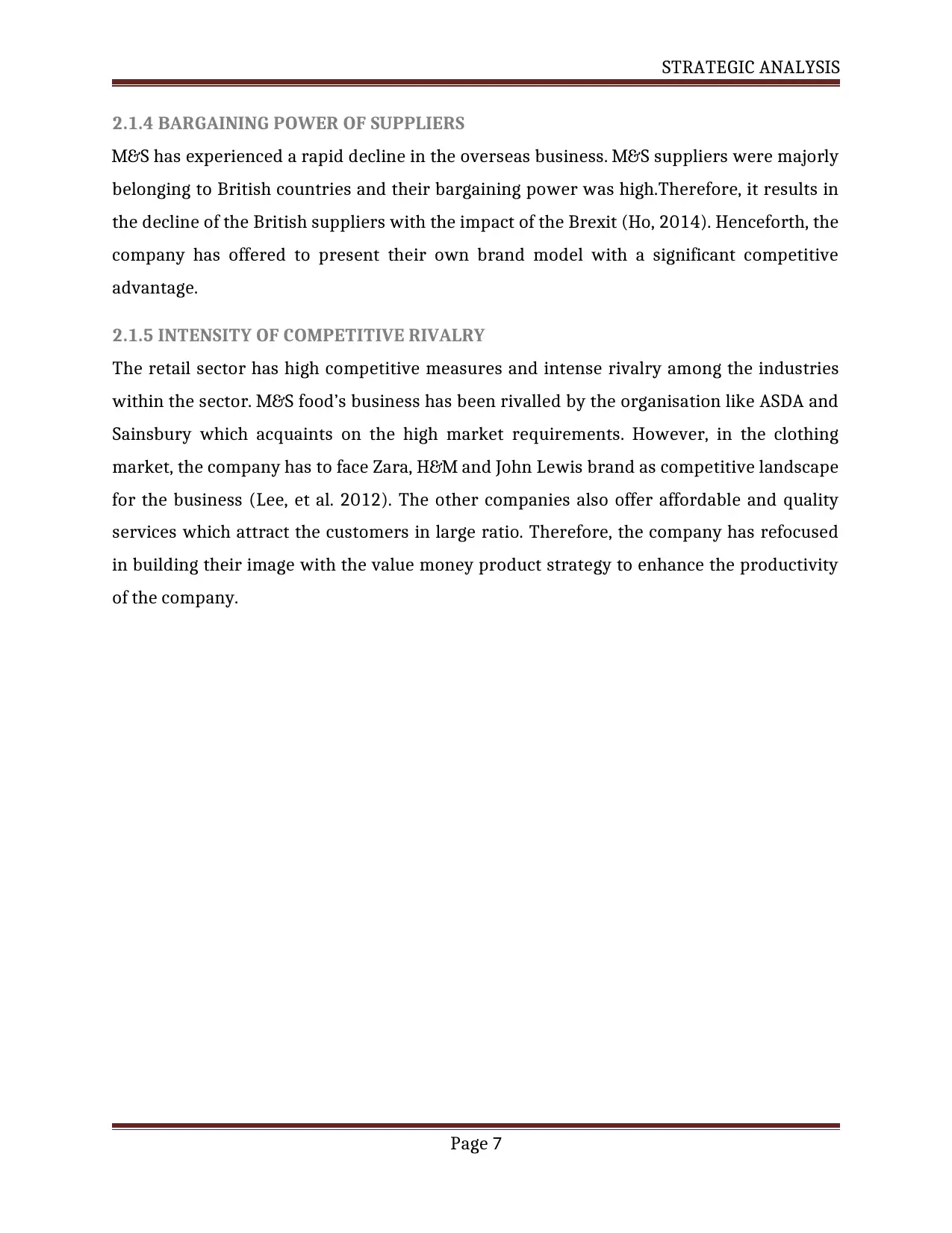
STRATEGIC ANALYSIS
2.1.4 BARGAINING POWER OF SUPPLIERS
M&S has experienced a rapid decline in the overseas business. M&S suppliers were majorly
belonging to British countries and their bargaining power was high.Therefore, it results in
the decline of the British suppliers with the impact of the Brexit (Ho, 2014). Henceforth, the
company has offered to present their own brand model with a significant competitive
advantage.
2.1.5 INTENSITY OF COMPETITIVE RIVALRY
The retail sector has high competitive measures and intense rivalry among the industries
within the sector. M&S food’s business has been rivalled by the organisation like ASDA and
Sainsbury which acquaints on the high market requirements. However, in the clothing
market, the company has to face Zara, H&M and John Lewis brand as competitive landscape
for the business (Lee, et al. 2012). The other companies also offer affordable and quality
services which attract the customers in large ratio. Therefore, the company has refocused
in building their image with the value money product strategy to enhance the productivity
of the company.
Page 7
2.1.4 BARGAINING POWER OF SUPPLIERS
M&S has experienced a rapid decline in the overseas business. M&S suppliers were majorly
belonging to British countries and their bargaining power was high.Therefore, it results in
the decline of the British suppliers with the impact of the Brexit (Ho, 2014). Henceforth, the
company has offered to present their own brand model with a significant competitive
advantage.
2.1.5 INTENSITY OF COMPETITIVE RIVALRY
The retail sector has high competitive measures and intense rivalry among the industries
within the sector. M&S food’s business has been rivalled by the organisation like ASDA and
Sainsbury which acquaints on the high market requirements. However, in the clothing
market, the company has to face Zara, H&M and John Lewis brand as competitive landscape
for the business (Lee, et al. 2012). The other companies also offer affordable and quality
services which attract the customers in large ratio. Therefore, the company has refocused
in building their image with the value money product strategy to enhance the productivity
of the company.
Page 7
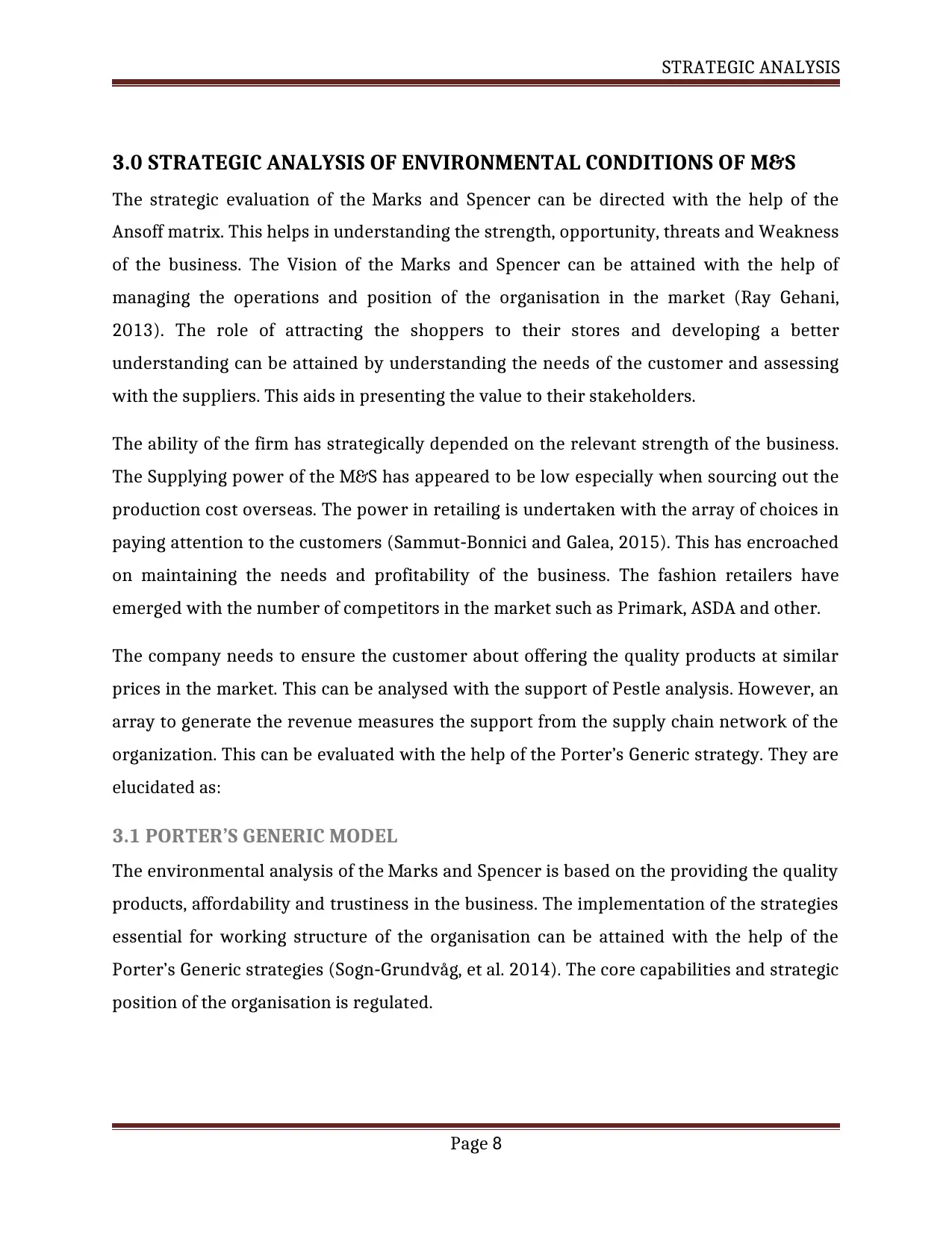
STRATEGIC ANALYSIS
3.0 STRATEGIC ANALYSIS OF ENVIRONMENTAL CONDITIONS OF M&S
The strategic evaluation of the Marks and Spencer can be directed with the help of the
Ansoff matrix. This helps in understanding the strength, opportunity, threats and Weakness
of the business. The Vision of the Marks and Spencer can be attained with the help of
managing the operations and position of the organisation in the market (Ray Gehani,
2013). The role of attracting the shoppers to their stores and developing a better
understanding can be attained by understanding the needs of the customer and assessing
with the suppliers. This aids in presenting the value to their stakeholders.
The ability of the firm has strategically depended on the relevant strength of the business.
The Supplying power of the M&S has appeared to be low especially when sourcing out the
production cost overseas. The power in retailing is undertaken with the array of choices in
paying attention to the customers (Sammut Bonnici and Galea, 2015). This has encroached‐
on maintaining the needs and profitability of the business. The fashion retailers have
emerged with the number of competitors in the market such as Primark, ASDA and other.
The company needs to ensure the customer about offering the quality products at similar
prices in the market. This can be analysed with the support of Pestle analysis. However, an
array to generate the revenue measures the support from the supply chain network of the
organization. This can be evaluated with the help of the Porter’s Generic strategy. They are
elucidated as:
3.1 PORTER’S GENERIC MODEL
The environmental analysis of the Marks and Spencer is based on the providing the quality
products, affordability and trustiness in the business. The implementation of the strategies
essential for working structure of the organisation can be attained with the help of the
Porter’s Generic strategies (Sogn Grundvåg, et al. 2014). The core capabilities and strategic‐
position of the organisation is regulated.
Page 8
3.0 STRATEGIC ANALYSIS OF ENVIRONMENTAL CONDITIONS OF M&S
The strategic evaluation of the Marks and Spencer can be directed with the help of the
Ansoff matrix. This helps in understanding the strength, opportunity, threats and Weakness
of the business. The Vision of the Marks and Spencer can be attained with the help of
managing the operations and position of the organisation in the market (Ray Gehani,
2013). The role of attracting the shoppers to their stores and developing a better
understanding can be attained by understanding the needs of the customer and assessing
with the suppliers. This aids in presenting the value to their stakeholders.
The ability of the firm has strategically depended on the relevant strength of the business.
The Supplying power of the M&S has appeared to be low especially when sourcing out the
production cost overseas. The power in retailing is undertaken with the array of choices in
paying attention to the customers (Sammut Bonnici and Galea, 2015). This has encroached‐
on maintaining the needs and profitability of the business. The fashion retailers have
emerged with the number of competitors in the market such as Primark, ASDA and other.
The company needs to ensure the customer about offering the quality products at similar
prices in the market. This can be analysed with the support of Pestle analysis. However, an
array to generate the revenue measures the support from the supply chain network of the
organization. This can be evaluated with the help of the Porter’s Generic strategy. They are
elucidated as:
3.1 PORTER’S GENERIC MODEL
The environmental analysis of the Marks and Spencer is based on the providing the quality
products, affordability and trustiness in the business. The implementation of the strategies
essential for working structure of the organisation can be attained with the help of the
Porter’s Generic strategies (Sogn Grundvåg, et al. 2014). The core capabilities and strategic‐
position of the organisation is regulated.
Page 8
⊘ This is a preview!⊘
Do you want full access?
Subscribe today to unlock all pages.

Trusted by 1+ million students worldwide
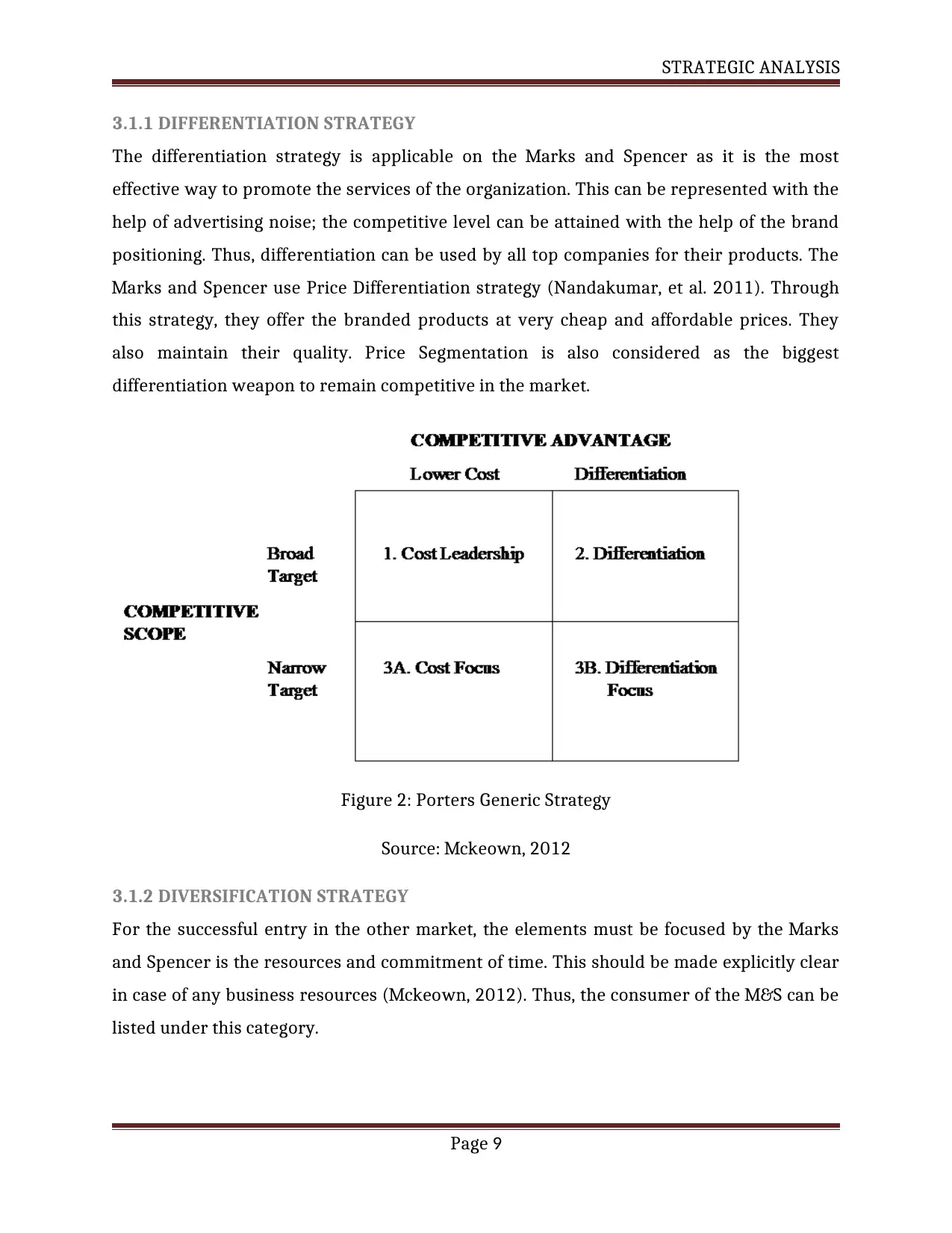
STRATEGIC ANALYSIS
3.1.1 DIFFERENTIATION STRATEGY
The differentiation strategy is applicable on the Marks and Spencer as it is the most
effective way to promote the services of the organization. This can be represented with the
help of advertising noise; the competitive level can be attained with the help of the brand
positioning. Thus, differentiation can be used by all top companies for their products. The
Marks and Spencer use Price Differentiation strategy (Nandakumar, et al. 2011). Through
this strategy, they offer the branded products at very cheap and affordable prices. They
also maintain their quality. Price Segmentation is also considered as the biggest
differentiation weapon to remain competitive in the market.
Figure 2: Porters Generic Strategy
Source: Mckeown, 2012
3.1.2 DIVERSIFICATION STRATEGY
For the successful entry in the other market, the elements must be focused by the Marks
and Spencer is the resources and commitment of time. This should be made explicitly clear
in case of any business resources (Mckeown, 2012). Thus, the consumer of the M&S can be
listed under this category.
Page 9
3.1.1 DIFFERENTIATION STRATEGY
The differentiation strategy is applicable on the Marks and Spencer as it is the most
effective way to promote the services of the organization. This can be represented with the
help of advertising noise; the competitive level can be attained with the help of the brand
positioning. Thus, differentiation can be used by all top companies for their products. The
Marks and Spencer use Price Differentiation strategy (Nandakumar, et al. 2011). Through
this strategy, they offer the branded products at very cheap and affordable prices. They
also maintain their quality. Price Segmentation is also considered as the biggest
differentiation weapon to remain competitive in the market.
Figure 2: Porters Generic Strategy
Source: Mckeown, 2012
3.1.2 DIVERSIFICATION STRATEGY
For the successful entry in the other market, the elements must be focused by the Marks
and Spencer is the resources and commitment of time. This should be made explicitly clear
in case of any business resources (Mckeown, 2012). Thus, the consumer of the M&S can be
listed under this category.
Page 9
Paraphrase This Document
Need a fresh take? Get an instant paraphrase of this document with our AI Paraphraser
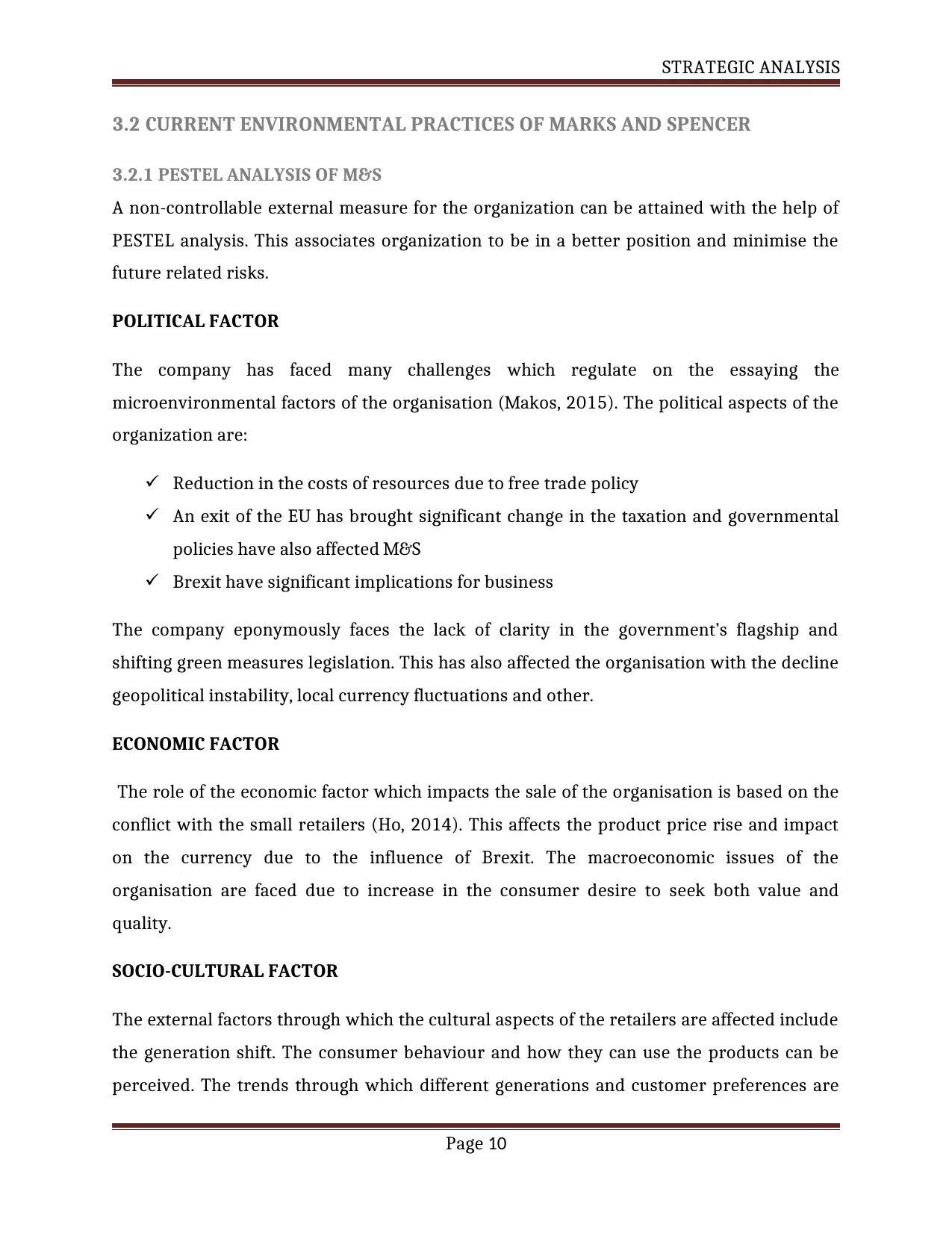
STRATEGIC ANALYSIS
3.2 CURRENT ENVIRONMENTAL PRACTICES OF MARKS AND SPENCER
3.2.1 PESTEL ANALYSIS OF M&S
A non-controllable external measure for the organization can be attained with the help of
PESTEL analysis. This associates organization to be in a better position and minimise the
future related risks.
POLITICAL FACTOR
The company has faced many challenges which regulate on the essaying the
microenvironmental factors of the organisation (Makos, 2015). The political aspects of the
organization are:
Reduction in the costs of resources due to free trade policy
An exit of the EU has brought significant change in the taxation and governmental
policies have also affected M&S
Brexit have significant implications for business
The company eponymously faces the lack of clarity in the government’s flagship and
shifting green measures legislation. This has also affected the organisation with the decline
geopolitical instability, local currency fluctuations and other.
ECONOMIC FACTOR
The role of the economic factor which impacts the sale of the organisation is based on the
conflict with the small retailers (Ho, 2014). This affects the product price rise and impact
on the currency due to the influence of Brexit. The macroeconomic issues of the
organisation are faced due to increase in the consumer desire to seek both value and
quality.
SOCIO-CULTURAL FACTOR
The external factors through which the cultural aspects of the retailers are affected include
the generation shift. The consumer behaviour and how they can use the products can be
perceived. The trends through which different generations and customer preferences are
Page 10
3.2 CURRENT ENVIRONMENTAL PRACTICES OF MARKS AND SPENCER
3.2.1 PESTEL ANALYSIS OF M&S
A non-controllable external measure for the organization can be attained with the help of
PESTEL analysis. This associates organization to be in a better position and minimise the
future related risks.
POLITICAL FACTOR
The company has faced many challenges which regulate on the essaying the
microenvironmental factors of the organisation (Makos, 2015). The political aspects of the
organization are:
Reduction in the costs of resources due to free trade policy
An exit of the EU has brought significant change in the taxation and governmental
policies have also affected M&S
Brexit have significant implications for business
The company eponymously faces the lack of clarity in the government’s flagship and
shifting green measures legislation. This has also affected the organisation with the decline
geopolitical instability, local currency fluctuations and other.
ECONOMIC FACTOR
The role of the economic factor which impacts the sale of the organisation is based on the
conflict with the small retailers (Ho, 2014). This affects the product price rise and impact
on the currency due to the influence of Brexit. The macroeconomic issues of the
organisation are faced due to increase in the consumer desire to seek both value and
quality.
SOCIO-CULTURAL FACTOR
The external factors through which the cultural aspects of the retailers are affected include
the generation shift. The consumer behaviour and how they can use the products can be
perceived. The trends through which different generations and customer preferences are
Page 10
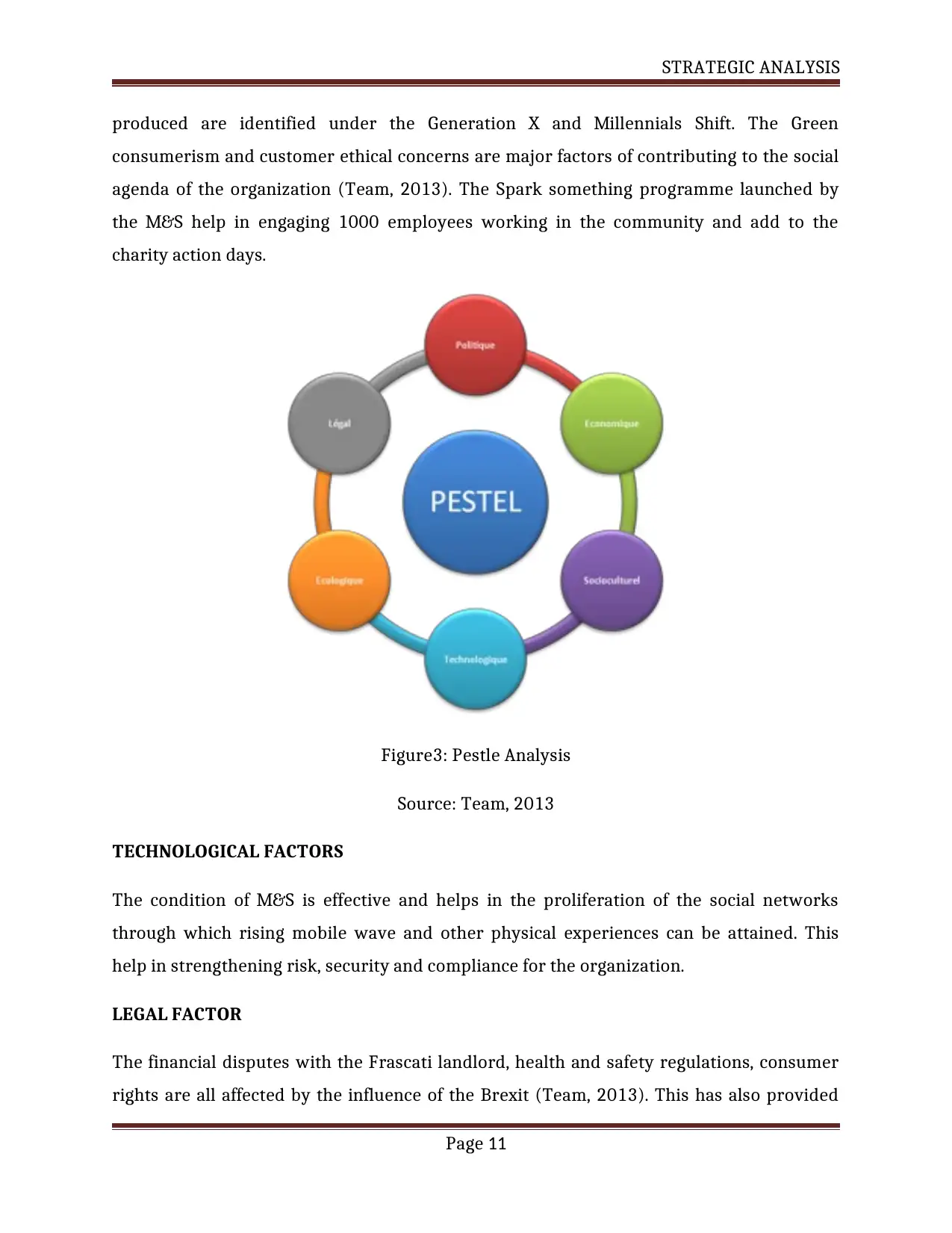
STRATEGIC ANALYSIS
produced are identified under the Generation X and Millennials Shift. The Green
consumerism and customer ethical concerns are major factors of contributing to the social
agenda of the organization (Team, 2013). The Spark something programme launched by
the M&S help in engaging 1000 employees working in the community and add to the
charity action days.
Figure3: Pestle Analysis
Source: Team, 2013
TECHNOLOGICAL FACTORS
The condition of M&S is effective and helps in the proliferation of the social networks
through which rising mobile wave and other physical experiences can be attained. This
help in strengthening risk, security and compliance for the organization.
LEGAL FACTOR
The financial disputes with the Frascati landlord, health and safety regulations, consumer
rights are all affected by the influence of the Brexit (Team, 2013). This has also provided
Page 11
produced are identified under the Generation X and Millennials Shift. The Green
consumerism and customer ethical concerns are major factors of contributing to the social
agenda of the organization (Team, 2013). The Spark something programme launched by
the M&S help in engaging 1000 employees working in the community and add to the
charity action days.
Figure3: Pestle Analysis
Source: Team, 2013
TECHNOLOGICAL FACTORS
The condition of M&S is effective and helps in the proliferation of the social networks
through which rising mobile wave and other physical experiences can be attained. This
help in strengthening risk, security and compliance for the organization.
LEGAL FACTOR
The financial disputes with the Frascati landlord, health and safety regulations, consumer
rights are all affected by the influence of the Brexit (Team, 2013). This has also provided
Page 11
⊘ This is a preview!⊘
Do you want full access?
Subscribe today to unlock all pages.

Trusted by 1+ million students worldwide
1 out of 19
Related Documents
Your All-in-One AI-Powered Toolkit for Academic Success.
+13062052269
info@desklib.com
Available 24*7 on WhatsApp / Email
![[object Object]](/_next/static/media/star-bottom.7253800d.svg)
Unlock your academic potential
Copyright © 2020–2025 A2Z Services. All Rights Reserved. Developed and managed by ZUCOL.




